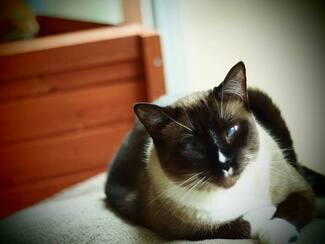
Have you ever wondered why cats’ coats in general and yours in purr-ticular change color?
If so, consider some of the paws-ible reasons for this feline phenomenon.
1) Changes in temperature: Some cats, like Oriental Himalayans and Siamese, known as pointed breeds, are genetically predisposed to changes in their fur color depending on the temperature of their skin. Their skin is naturally cooler at their bodies’ extremities – faces, paws and tails – which partly accounts for their white or light cream bodies and darker-hued faces, paws and tails. The temperature of the environment in which any cat lives can also play a role in her coloring. Owners may notice that their cats are darker during the cold months of winter and lighter during the warm months of spring and summer.
2) The sun’s rays: If your cat -- as most do -- LOVES the sun, her fur will change color and fade because of her prolonged exposure to its rays. Most noticeable in black cats whose coats lighten and turn “rusty,” it results from the sun’s UV rays destroying the dark pigment, melanin, in their bodies that protects their delicate skin from being burned. Thankfully, however, cats are constantly replacing melanin, meaning their fur will eventually return to its normal shade, but they’ll have to go through an entire shedding cycle before this happens. Nor does this type of fading apply only to outdoor cats. The coats of indoor cats who spend too much time stretched out on sunny window perchs will also fade.
3) Lack of important nutrients: Dark-haired cats may appear lighter or redder than usual due to an insufficient amount of the amino acid tyrosine in their diet. Considered a non-essential amino acid since it’s created within their own bodies, cats require twice as much tyrosine as their bodies can produce (the average cat needs over 5g of tyrosine daily). Tyrosine is needed to make melanin, and if cats don’t have enough of it in their diet, their fur can begin turning a reddish hue. Similarly, a diet high in such elements as copper or zinc may also cause their coats to change color.
4) The natural aging process: If your cat is 10 years or older, her body will automatically begin producing less melanin. But unless her coat is pure black as opposed to either a paler coat or one with stripes, you may not notice the change until her coat starts turning from its normal color to a browner and then, finally, to a grayer tone. Gray hairs customarily appear first around a cat’s muzzle and fan out from there.
5) Stress and physical pain: While still controversial, some experts believe that stress or pain may be responsible for turning a cat’s fur gray. Such premature graying is linked to heightened levels of noradrenaline, a hormone constantly released by a cat’s body in small doses. Noradrenaline is connected to the nervous system, and during times of intense stress or pain, it will, literally and figuratively, flood her body.
If, on the other hand, your cat’s fur has changed color seemingly overnight, there could be a medical reason for it, and you should arrange to have her seen by your vet.










 RSS Feed
RSS Feed